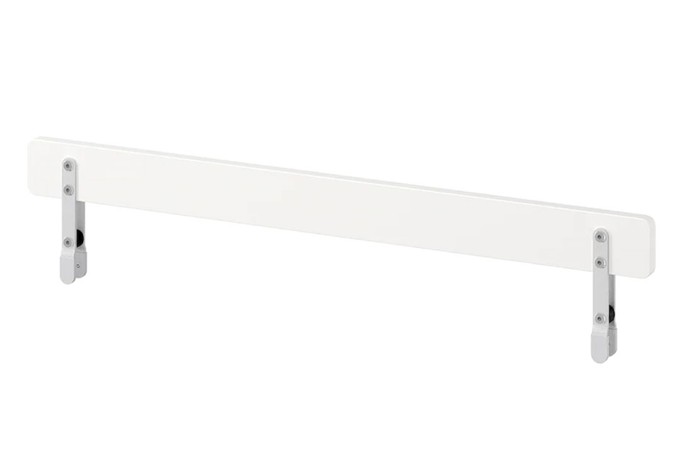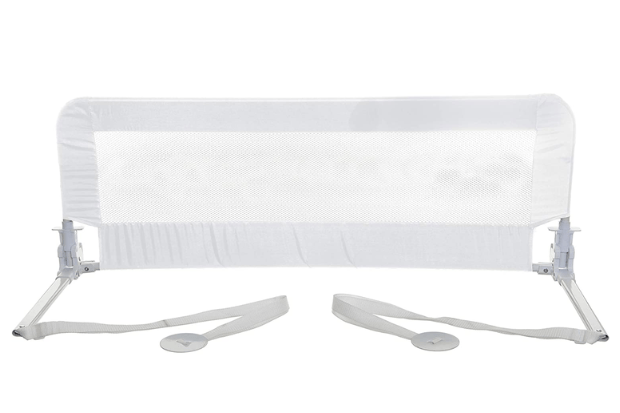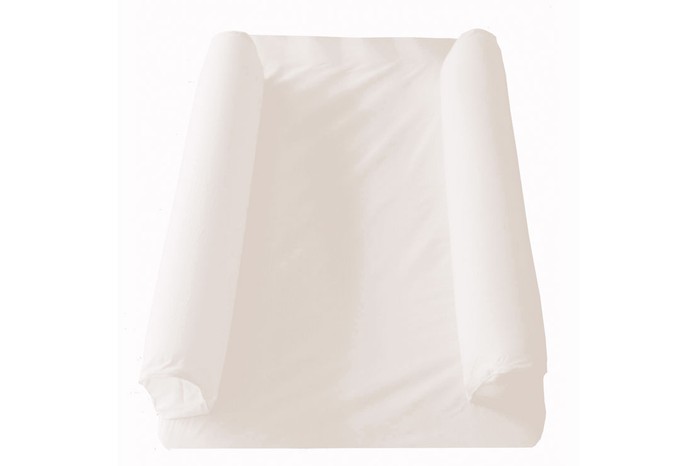What is a Bed Guard Rail?
A bed guard rail, also known as a bed rail or safety rail, is a protective barrier that attaches to the side of a bed to prevent children from accidentally rolling out during sleep. It serves as a transitional tool, allowing children to move from a crib to a regular bed while maintaining a sense of security and minimizing the risk of falls.
Benefits of Bed Guard Rails:
- Fall Prevention:
The primary purpose of a bed guard rail is to prevent falls during sleep. Young children, particularly those who are newly transitioned to a bed, may experience rolling or tossing movements during the night, increasing the likelihood of accidental falls. Bed guard rails act as a physical barrier, providing a safe sleeping area and reducing the risk of injuries.
- Independence and Confidence:
- Peace of Mind for Parents:
Types of Bed Guard Rails:
Fixed Bed Rails:
Fixed bed guard rails are designed to be permanently attached to the bed frame. They are typically made of durable materials such as metal or wood and offer a sturdy and reliable barrier. Fixed bed rails are ideal for long-term use and can be adjusted to fit different bed sizes.Folding Bed Rails:
Folding bed guard rails provide convenience and versatility. They can be easily folded down during the day for convenient access to the bed and folded up at night for added safety. Folding bed rails are often portable, making them suitable for travel or temporary use.Inflatable Bed Rails:
Inflatable bed guard rails offer a lightweight and portable option. They are typically made of PVC or similar materials and can be quickly inflated and deflated. Inflatable bed rails are ideal for travel, as they can be easily packed and carried along. However, it’s important to ensure they are properly inflated and securely attached to the bed.Tips for Selecting and Using Bed Guard Rails:
Compatibility:
When selecting a bed guard rail, ensure it is compatible with the size and type of bed you have. Measure the length and height of your child’s bed to ensure a proper fit. Some bed guard rails are adjustable to accommodate different bed sizes.Safety Standards:
Look for bed guard rails that meet safety standards and regulations. Check for certifications or labels indicating compliance with relevant safety guidelines.Installation:
Follow the manufacturer’s instructions for proper installation of the bed guard rail. Ensure it is securely attached to the bed frame to prevent accidental detachment.Maintenance and Cleaning:
Regularly inspect the bed guard rail for any signs of wear or damage. Keep it clean by following the manufacturer’s cleaning instructions. Remove any sharp or protruding edges that may pose a risk to your child.
Transition Period:
Introduce the bed guard rail to your child as part of their transition from a crib to a bed. Encourage them to familiarize themselves with the rail and demonstrate how to enter and exit the bed safely.Monitor and Supervise:
While bed guard rails provide added safety, it’s important to remember that adult supervision is still necessary. Regularly check on your child during sleep to ensure their well-being.When do you need a child bed guard?
Bed guards and rails are aimed at toddlers, with the recommended age usually being from 18 months to 5 years. Many manufacturers advise not using a bed rail on a sleeping surface that is more than 60cm from the floor, so they wouldn’t be suitable for the top bed of a bunk. Although moving from a cot to a toddler bed is an exciting milestone, there is no reason to rush the transition unless your child is endangering themselves by trying to climb out of their cot. It’s often better to keep them in their cot for as long as possible. Remember toddler bed guards are not designed to be used with younger babies, as safe sleep guidelines say, for babies under 12 months, to keep their sleep space clear of anything that could pose a suffocation risk. Keeley Black, a baby safety expert who runs SafeCircle babysitting advises that toddler bed guards can be used by children up to around 5 years old, however, it may be a good idea to remove them earlier if your child is climbing over them to get out of their bed to prevent falls and injury. The guard could be used on a single bed instead which would give the child space at the bottom of the bed to get out safely.What are the different types of toddler bed guards?
There are various styles of child bed guards. Some are more rigid and solid, for example, those made of wood that provides a straight-forward barrier, similar to a bunk bed rail, to stop children from falling over the side. Other toddler bed guards are made from foam or fabric such as mesh, so they are softer and less rigid if children like to sleep up against the side. You can also find inflatable bed guards that protect your child and can be particularly handy for travelling, as they can be deflated and transported away with you. Baby safety expert Keeley says, “the bed guard should have a clear airflow around it so try and use mesh, wooden slatted or low rise guards where possible”.What to look for when choosing the best bed guard for your child
Safety – Baby expert, Dean smith, director of For Your Little One had a few tips for choosing a bed guard safely. He said to always measure your toddler’s bed first, it should not prevent them from getting in and out of bed and it should sit firmly to cover the middle of the bed, not cover the whole length. Similarly, he advises measuring your toddler’s mattress height as you need to find one that is suitable. He also suggest making sure it is breathable as your toddler may be breathing up against the side of it during the night so it’s vital they can comfortably breathe if that does happen.
Size
As our expert Dean previously mentioned, Measure your child’s bed and mattress and compare this with the dimensions of the guard you intend to buy. We’ve listed the dimensions of each product in our top 10 so you can make sure it won’t be too long or short for your child’s new bed.Bed position
Where in the bedroom will the bed be? If the bed’s in the centre of the room, with both sides open, you might need 2 bed rails to secure both sides. If the bed is placed alongside a wall then you have a natural barrier on one side and only need to guard the other. Compatibility with your child’s bed – Some child bed guards are not compatible with certain types of beds, especially divans, so check before you buy.Portability
Do you want a rail that’s permanently fixed to the bed? Or one that could be moved for times when your toddler is sleeping elsewhere, such as holidays and family visits?Ease of cleaning
The wooden rails have the advantage of being easy to wipe down, whereas the fabric rails can usually be hand washed.
Material – Bed guards come in all different materials; inflatable, foam or wooden. It’s important to consider which type of bed guard would work well for your child and their bed.
1. Costway Adjustable Toddler Bed Rail
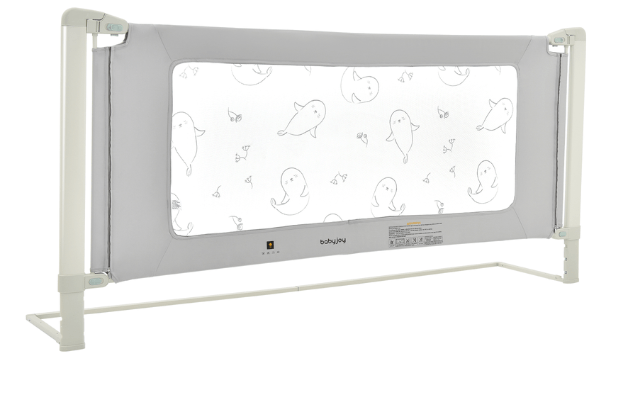 Dimensions: H80-95cm x W47cm x L150 OR 180cm | Material: Iron and brushed cloth | Colours available: Grey
This bed rail is great for mattresses of all heights thanks to its 4 adjustable height settings, it can range from 80 to 93cm high. It can also be lifted independently from each side making it really convenient when parents only have one hand free to get their child into bed.
The breathable mesh ensures good ventilation for your child, whilst also being transparent enough to see through to check your child is safe and sleeping soundly. Unlike most bed guards where it swings down for access, this one lifts down to allow you easy access to your child.
Dimensions: H80-95cm x W47cm x L150 OR 180cm | Material: Iron and brushed cloth | Colours available: Grey
This bed rail is great for mattresses of all heights thanks to its 4 adjustable height settings, it can range from 80 to 93cm high. It can also be lifted independently from each side making it really convenient when parents only have one hand free to get their child into bed.
The breathable mesh ensures good ventilation for your child, whilst also being transparent enough to see through to check your child is safe and sleeping soundly. Unlike most bed guards where it swings down for access, this one lifts down to allow you easy access to your child.2. Ikea Vikare Guard Rail
Trust Ikea to come up with one of the most simple, stylish and affordable bed guards out there. It’s a small and non-intrusive way to help keep your toddler a little more secure in those early months after moving to a bed.
The Vikare is easy to fit, and can be attached with screws to cot beds and normal beds. It doesn’t have arms that reach under the bed, making it slightly less sturdy than those that do, but it is smaller overall so doesn’t need such a strong support. Admittedly, the Vikare is quite a hard, rigid addition to the bed, but it doesn’t look too overpowering in its neutral white design. Also, as it’s wooden, it can easily be wiped clean.
Note that this bed guard only fits children’s beds that have a straight 18-25mm thick bed rail or cot side.
Pros: Good value, easy to attach and can be wiped clean
Cons: Does not fit all beds, hard material and not as high as others
3. BabyDan Wooden Bed Guard Rail
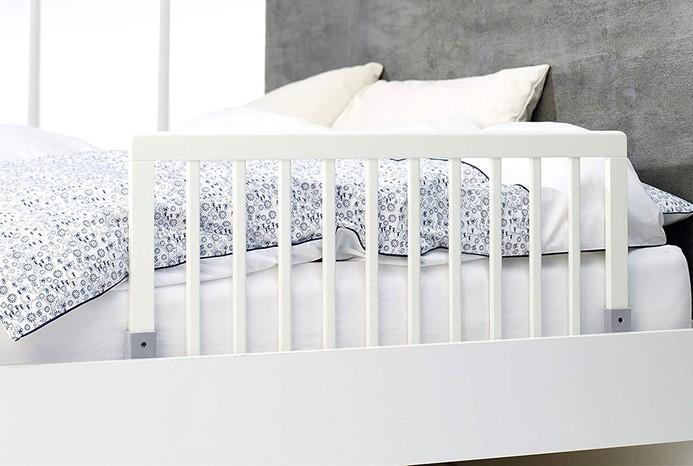 This solid and stylish wooden bed guard rail from BabyDan is made from furniture grade wood, so has a nice quality to it and should be long-lasting. But most importantly, it attaches and detaches easily, with no tools required.
BabyDan also says it’s suitable for all beds (not including cribs and upper bunk beds), so you can be reassured that it’ll stay secure no matter your child’s style of bed.
Parent tester Tania, mum of 2, aged 14 weeks and 3 used this with her toddler and loved that you could take the side off, saying “it worked well for us; it was easy to clean and looked good”.
Pros: Aesthetically pleasing, strong and sturdy, no tools needed to attach
Cons: Not suitable for upper bunk beds and hard material
This solid and stylish wooden bed guard rail from BabyDan is made from furniture grade wood, so has a nice quality to it and should be long-lasting. But most importantly, it attaches and detaches easily, with no tools required.
BabyDan also says it’s suitable for all beds (not including cribs and upper bunk beds), so you can be reassured that it’ll stay secure no matter your child’s style of bed.
Parent tester Tania, mum of 2, aged 14 weeks and 3 used this with her toddler and loved that you could take the side off, saying “it worked well for us; it was easy to clean and looked good”.
Pros: Aesthetically pleasing, strong and sturdy, no tools needed to attach
Cons: Not suitable for upper bunk beds and hard material4. Safety 1st Portable Bed Rail
This bed guard has a standard mesh design with great functionality. It can fold down to allow easy access to bed, and it can also be slid together (down to 66cm) to make it more compact and portable – great for taking along on family visits or on holiday. No assembly is required – ideal if you want something simple to install.
This bed rail is compatible with mattresses with a length greater than 156cm and a thickness from 10 to 24cm and fits slatted and standard beds.
Parent tester Joanna, mum of 2, aged 5 and 3 used this bed guard with her children when they were slightly younger and loved how “it was really sturdy, simple to use and folded down smaller for travel which was a real bonus, it did what it needed to do for both our kids”.
Pros: Can be folded down compactly for travel, easy access to the bed and good value
Cons: Hard metal frame and not the most visually appealing
5. Dreambaby Phoenix Foldable Bedrail
Dimensions: H45.5cm x L110cm (H45.5 x L55 when folded)| Material: Metal frame and netting | Colours available: White and grey
The Dreambaby Phoenix Foldable bed rail is super easy to clean thanks to its removable and washable cover. It also makes getting your toddler in and out of bed easy too with its convenient fold down sides – this will be handy when making the bed too.
The bed rail is fairly easy to install but there is assembly required. It can be quite compact, however it does have to be disassembled to fit in its carry bag so it is a quite a bit more work to move it around.
It’s suitable for divans and slatted bed bases and for mattresses between 10 to 25cm thick: it can be slightly adjusted depending on the mattress thickness.
Parent tester Lorne, mum of kids aged 2 and 4 uses this with her toddler and said, “I like the breathable mesh and that the cover is washable too. It’s very sturdy and fits my child’s single bed well”.
Pros: Easy to clean and can be compact if needed
Cons: Requires assembly and has a hard metal frame
6. Hippychick Dream Tubes bed guards
Dimensions: H90 x L195cm (Dream Tubes single sheet), H70cm x L140cm (Dream Tubes cot bed sheet) | Material: inflatable and cotton | Colours available: White
Designed by 2 mums after one too many sleepless nights, inflatable Dream Tubes are a slightly different option for keeping your child from rolling out of bed. Simply blow them up then pop them in the pockets of a special sheet – either cotbed or single bed size – to make a cosy barrier to help kids stay put. We love the fact that this product includes the custom sheet, which effectively keeps the bumpers (2 per pack) in place.
These are great for if your child’s bed is not against a wall as you get 2 bumpers and can protect them from falling out of bed both sides. The sheet that covers the inflatable tube is also machine washable. Compared to the harder wooden and metal/mesh frames, this is much softer if your child kicks it or rolls into it.
The bumpers are very lightweight and fold up to a small handy size, making transport a doddle. You can take them with you everywhere – no more rearranging the furniture to prevent kids from rolling out of bed.
Pros: get 2 in a pack so protects both sides, soft material, and can fold up
Cons: Does require blowing up and placing sheet on top and may not offer as high protection a wooden or metal rail
